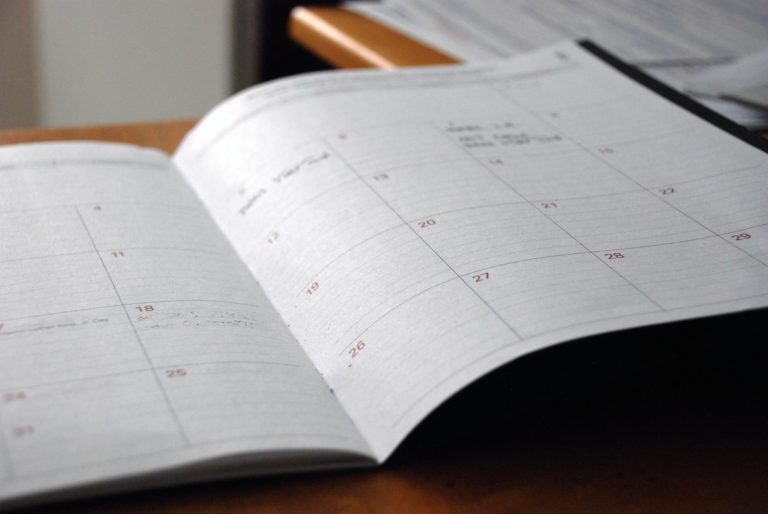Atomic Habits by James Clear | Book Summary
Atomic “Habits are the compound interest of self-improvement.”
James Clear, author of Atomic Habits
In the book, Atomic Habits: An Easy and Proven Way to Build Good Habits and Break Bad Ones, James Clear provides practical strategies to create good habits, break bad habits, and master the small actions that will lead to excellent results.
If you struggle with your habits, you need to change your system. This book will help you implement a proven system to break the toughest of habits and build atomic habits:
- Atomic – “an extremely small amount of a thing; the single irreducible unit of a larger system; the source of immense energy or power”
- Habit – “a routine or practice performed regularly; an automatic response to a specific situation”
Buy Atomic Habits on Amazon
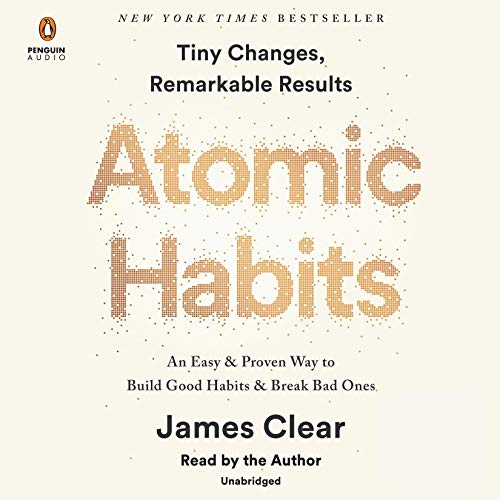
Atomic Habits by James Clear
An Easy and Proven Way to Build Good Habits and Break Bad Ones
Since 2012, James Clear has written many articles on habit formation, which has led him to become one of the world’s renowned experts on establishing habits. In Atomic Habits, James Clear integrates the most established ideas from biology, psychology, and neuroscience to make it easy to build good habits and break bad habits.
For further reading on habits, check out The Power of Habit (book summary) by Charles Duhigg. For more resources, check out the Atomic Habits website here or download my Atomic Babits cheat sheet:
Download the PDF Book Summary for Atomic Habits by James Clear
Without further ado, let’s get into the Atomic Habits chapters below!
The Fundamentals: Why Tiny Changes Make a Big Difference

Chapter 1: The Surprising Power Of Atomic Habits
In Chapter 1 of Atomic Habits, James Clear demonstrates how small habits can compound to making a massive difference in your growth. Therefore, if you were to improve by one percent daily, the math provides extraordinary results in the long run:
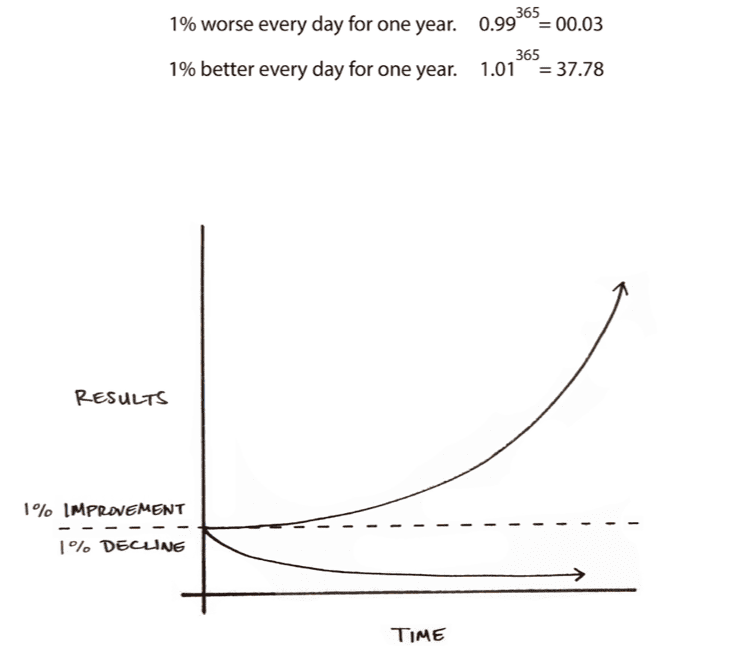
If you get 1% better each day, you will become 37% times better in a year. In contrast, if you become 1% worse each day, you will decrease close to nothing (zero). Good habits can work for you like a double-edged sword, while bad ones go against you.
Often, there is a gap between what we expect to happen and what actually happens. Until you reach a critical threshold, your small changes will seem to make no difference. Typically, we expect progress to be linear; however, the results of our habits are delayed:
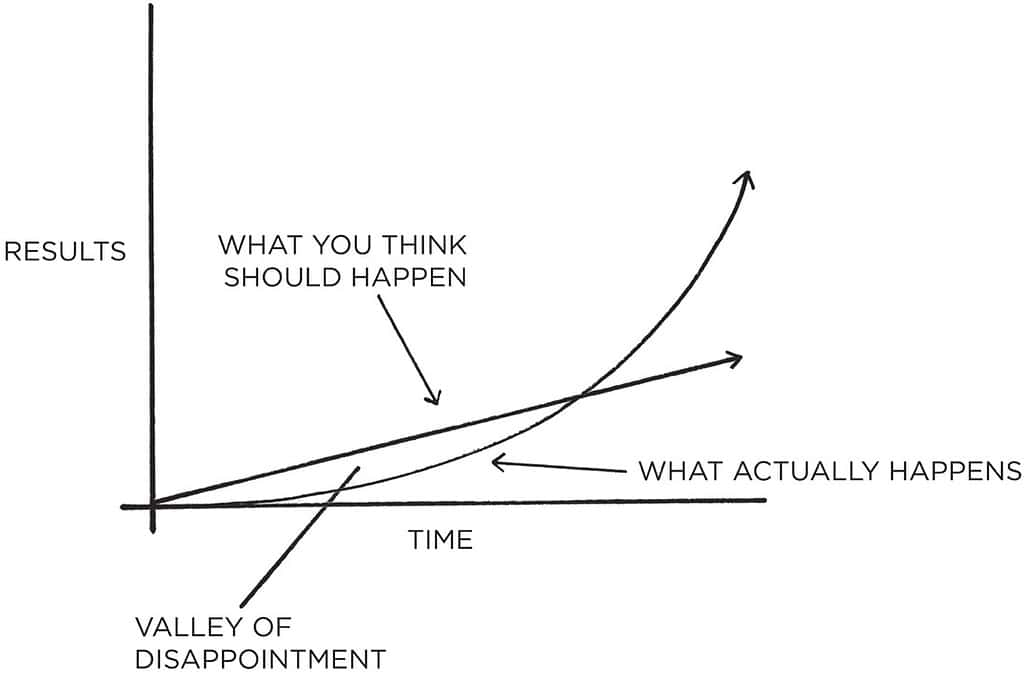
We can get discouraged and fall into the “Valley of Disappointment,” but it may not be a waste of your time, and you need to be patient with your outcomes. Therefore, you need to be patient to cross the critical threshold.
SMART goals are the outcomes you want to achieve, with the systems being the processes that produce those results. The following issues arise when you are much more focused on your goals versus establishing systems:
- Winners and losers have the same goals as goal setting suffers from survivorship bias.
- Achieving a goal is only a temporary change as the inputs are typically the real issue.
- Goals restrict your happiness as it is said, “Once I reach my goal, then I’ll be happy.”
- Goals are at odds with long-term progress, as what do you do once you have won.
Therefore, “You do not rise to the level of your goals. You fall to the level of your systems.” The building block of the more extensive system and incredible results is the atomic habit:
Atomic Habits – “a regular practice or routine that is not only small and easy to do but also the source of incredible power; a component of the system of compound growth”
Consistent habits that are performed daily can help you reduce results from a year to just 12 weeks.
Chapter 2: How Your Habits Shape Your Identity (And Vice Versa)
“Changing our habits is challenging for two reasons: (1) we try to change the wrong thing and (2) we try to change our habits in the wrong way.” In Chapter 2 of Atomic Habits, James Clear addresses the first point by demonstrating how your habits shape your identity.
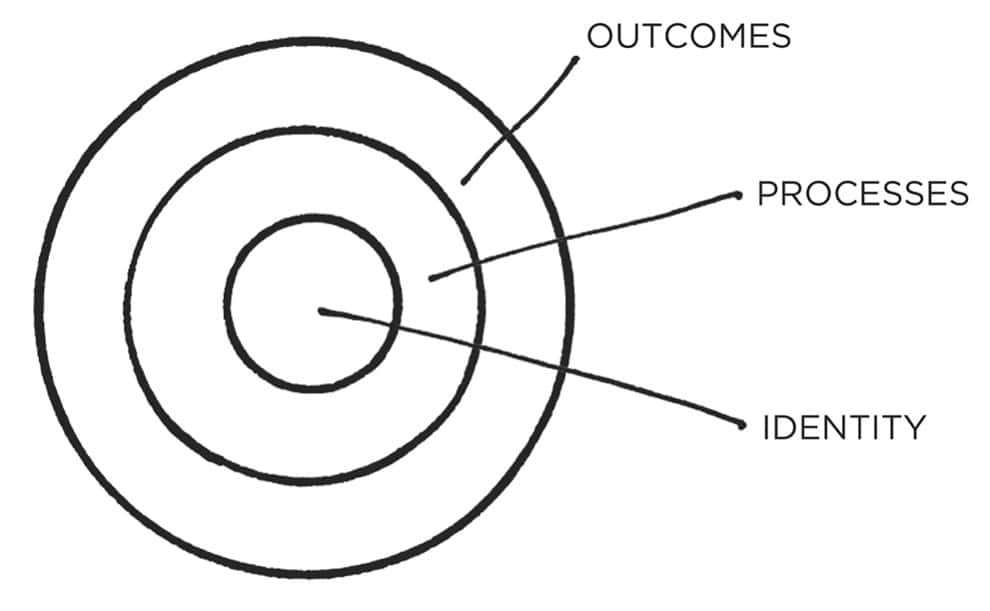
Regarding changing the wrong thing, are three levels at which behavior change can occur:
- Outcome Change – concerned with changing your results
- Process Change – concerned with changing your habits and systems
- Identity Change – concerted with changing your beliefs
As outcomes are what you get and processes are what you do, identify is as follows:
Identify – what you believe; emerges out of your habits with every action being a vote for the type of person you wish to become
Thus, you can effectively change your habits by focusing on who you want to be (identify) and not on what you wish to accomplish (outcome). There are two steps for changing your identity:
- Decide the type of person you want to be.
- Prove it to yourself with small wins.
You need to challenge your beliefs and grow your identity to be the best version of yourself. In these transformations, your habits can change your personal beliefs while creating extraordinary results.
Chapter 3: How To Build Atomic Habits In 4 Simple Steps
In Chapter 3 of Atomic Habits, James Clear shows you how to build better habits in the four steps of habit formations. First, he defines a habit:
Habit – “a behavior that has been repeated enough times to become automatic”
Habits help us solve issues in our lives using as little of our limited personal resources of energy and attention as possible. The process of building a habit is captured by:
The Habit Loop – the feedback loop to describe the four steps of habit formation:
- Cue – the trigger in your brain that initiates a behavior
- Craving – the motivational force behind each habit
- Response – the actual habit that you performed in thought or action
- Reward – the end goal of every habit that satisfies and teaches you

The “cue triggers a craving, which motivates a response, which provides a reward, which satisfies the craving and ultimately, becomes associated with the cue.” Clear reframes the four steps into the following laws with inversions of the four laws:
Four Laws of Behavior Change – the simple set of rules to build better habits:
- Make It Obvious (Cue)
- Make It Attractive (Craving)
- Make It Easy (Response)
- Make It Satisfying (Reward)
Inversion of the Four Laws – the opposite of the Four Laws to break bad habits:
- Make It Invisible (Cue)
- Make It Unattractive (Craving)
- Make It Difficult (Response)
- Make It Unsatisfying (Reward)
Download The PDF Book Summary For Atomic Habits By James Clear
The 1st Law: Make It Obvious
In this part of Atomic Habits, James Clear discusses the 1st Law of Behavior Change. First, the Cue triggers your brain to start a behavior. This stage provides the law to “Make it Obvious” to create a good habit. Inversely, it gives the rule to “Make it Invisible” to break a bad habit.
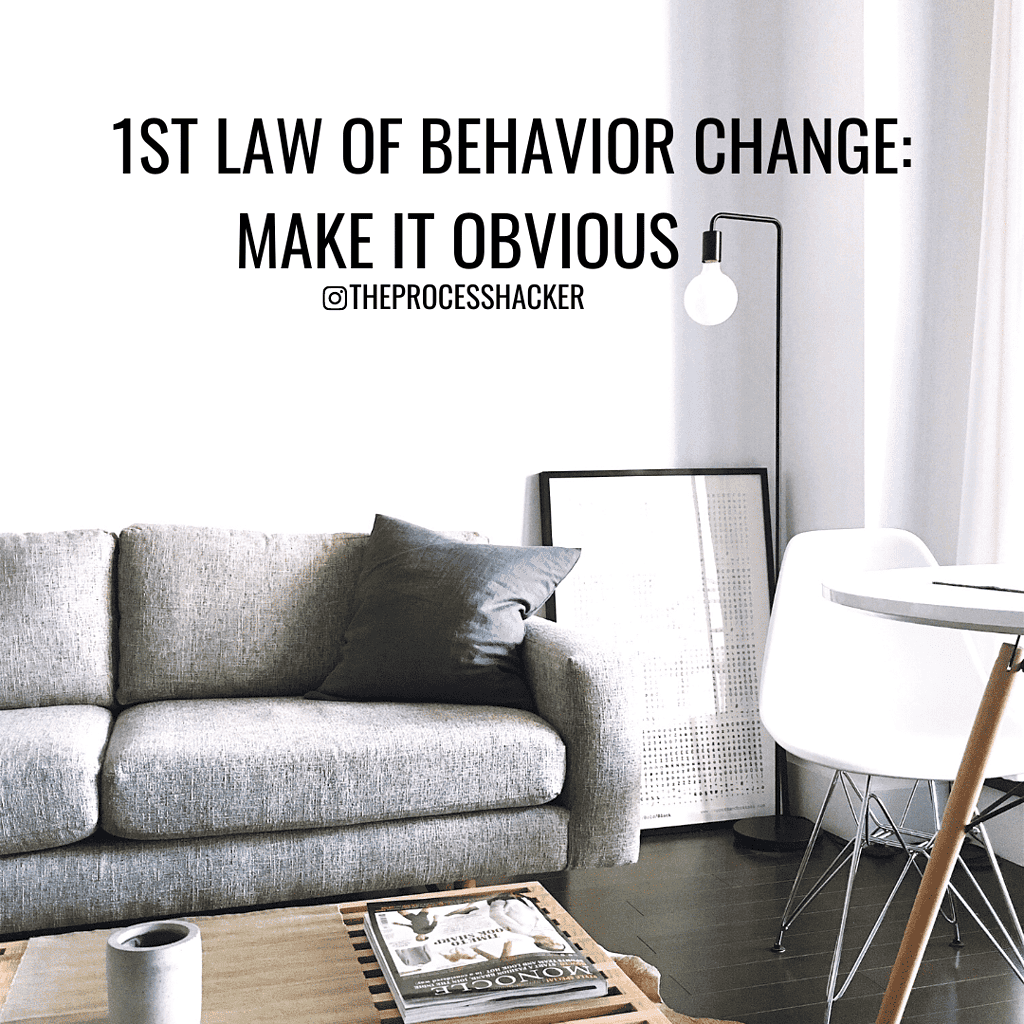
Chapter 4: The Man Who Didn’t Look Right
In Chapter 4 of Atomic Habits, James Clear shows you how to become aware of your habits. Over time with consistent practice, your brain will detect cues without much thought. Eventually, your habits become automatic, and you stop noticing the normal behavior.
First, you can change your bad habits by looking out for them. Then, you can take it one step further by trying the Japanese system Pointing-and-Calling in your own life:
Pointing-and-Calling – a method to raise awareness of a nonconscious habit by verbalizing your actions, such that one is conscious of performing the behavior
Saying out loud the action and outcome will make you aware of hearing your bad habits. The consequences seem real, and they will stick in your mind. However, the effects of bad habits can still be sneaky, so you can further implement the Habits Scorecard.
Habits Scorecard – a simple exercise to become more aware of your behavior by writing down and tracking your current daily habits; score each habit as good (+), bad (-), or a neutral (=)
If you are having trouble scoring each habit, envision how it will impact you in the long run or determine how it aligns with your story.
Chapter 5: The Best Way To Start A New Atomic Habit
In Chapter 5 of Atomic Habits, James Clear shows the best method to build a new habit. You can use the 1st Law of Behavior Change is to “Make it Obvious. First, you can plan when and where you perform a particular habit with an Implementation Intention:”
Implementation Intention – a strategy to pair a new habit with the two most common cues in the implementation intention formula: “I will [BEHAVIOR] at [TIME] in [LOCATION]”
- Behavior – the habit that you want to do
- Time – when you will perform the habit
- Location – where you will perform the habit
Specifically, you can use implementation intentions in your life using Habit Stacking formula:
Habit Stacking – an implementation intention strategy used to pair two or more habits together: “After [CURRENT HABIT], I will [NEW HABIT]”
- Current Habit – the habit that is already automatic
- New Habit(s) – the habit or set of habits that you will perform after the current habit
This method increases the chance of adhering to a new habit by stacking it on your current behaviors. Further, you can repeat this process to chain together many habits, with each habit being the cue for the next.
Chapter 6: Motivation Is Overrated; Environment Often Matters More
In Chapter 6 of Atomic Habits, James Clear argues that small changes in your context or environment can result in significant behavior changes over time. Since cues initiate every habit, our minds notice the signals that stand out. Over time, your habits form associations not only with a single trigger but rather with the entire context encompassing that behavior.
Therefore, we should redesign our surroundings to build great habits, make good habits obvious, and evade poor cues. For example, organizing your space such that every object has a place and purpose can lend itself to simply forming great habits. For more, check out The Life-Changing Magic Art of Tidying Up (book summary).
Chapter 7: The Secret To Self-Control
In Chapter 7 of Atomic Habits, James Clear discusses the inversion of the 1st Law of Behavior Change, which is to “Make it Invisible.” As habits become automatic, it is tough to forget them once established.
Many people use self-control to avoid bad habits; however, this strategy is short-term and does not work in the long run. Instead, those with high self-control simply spend less time being tempted than trying to resist it. Therefore, it is better to avoid tempting situations, specifically by reducing exposure to cues rather than fighting them.
Actions:
- Use the Habits Scorecard to gain awareness and track your current habits.
- Create new habits using implementation intentions and habit stacking.
- Redesign your environment such that the good cues become obvious and visible.
- Reduce your exposure to the cues that cause your bad habits.
Download The PDF Book Summary For Atomic Habits By James Clear
The 2nd Law: Make It Attractive
In this part of Atomic Habits, James Clear discusses the 2nd Law of Behavior Change. Second, the Craving is the underlying motivation for each habit. This stage provides the rule to “Make it Attractive” to create a good habit. Inversely, it gives the rule to “Make it Unattractive” to break a bad habit.

Chapter 8: How To Make An Atomic Habit Irresistible
In Chapter 8 of Atomic Habits, James Clear shows how to make habits more attractive. The attractiveness of an event correlates with the likelihood that it will become a habit. However, first, we must understand our cravings, which occur by measuring changes in dopamine levels:
Dopamine – a neurotransmitter released when your brain is expecting a reward
Behaviors that are likely to form habits, such as doing drugs, eating junk food, or surfing the web, are associated with high dopamine levels. These habits are encompassed by a dopamine-driven feedback loop:
Dopamine-Driven Feedback Loop – a self-perpetuating circuit that gets one to take action from the anticipation of the reward
“Dopamine is released not only when you experience pleasure, but also when you anticipate it.” And that anticipation of the reward that causes you to more likely take action. So, you can make habits more attractive by temptation bundling:
Temptation Bundling – a strategy of pairing a desired action (want) with a necessary action (need) as “more probable behaviors will reinforce less probable behaviors
Further, you can combine temptation bundling with habit stacking to create rules to guide your behavior using the following formula:
- After [CURRENT HABIT], I will [HABIT I NEED].
- After [HABIT I NEED], I will [HABIT I WANT].
Chapter 9: The Role Of Friends And Family In Shaping Your Atomic Habits
In Chapter 8 of Atomic Habits, James Clear illustrates how the people you surround yourself shape your habits and action. Previously, we discussed the rule of your environment in habit formation. Similarly, our social culture as we tend to imitate the following three social groups:
- Close – our Family and Friends: Proximity is powerful as the closer we are to someone, the more likely we will imitate them. Therefore, you can make habits more attractive by joining a culture in which:
- Your desired behavior is the standard behavior and
- You already have similarities with the social group.
- Many – our Tribe: There is immense pressure to conform to the group as it often overpowers the desired behavior of the individual. Therefore, make it attractive to change your habits with a tribe you want to fit in with.
- Powerful – those with Status and Prestige: It is human to pursue power, prestige, and status and avoid behavior that decreases any of these pursuits. Therefore, make it attractive by getting approval, respect, or praise for your habits.
Chapter 10: How To Find And Fix The Causes Of Your Bad Habits
In Chapter 10 of Atomic Habits, James Clear discusses the inversion of the 2nd Law of Behavior Change, which is to “Make it Unattractive.” Even though every habit has a craving on the surface, there is an underlying cause linked to an ancient desire. When your habit addresses the cause, you will develop a craving to repeat the behavior.
Over time, you can predict the artificial positive feeling when performing that bad habit. Therefore, you should reframe your positive habits to highlight their benefits and associate positive feelings using this insight. Vice versa, you can use a Con Sheet for bad habits:
Cons Sheet – a strategy to list the drawbacks of the bad habit or the reasons to avoid it and make it seem unattractive
Further, you can practice associating your habits with something enjoyable and employ that cue within a ritual when you require motivation:
Motivation Ritual – a strategy to perform an enjoyable activity to inspire you to perform the difficult habit
Actions:
- Use Temptation Bundling to pair an action that you want to do with one that you need to do.
- Join and embrace a community in which your desired behaviors are the norm.
- List out the advantages of avoiding your bad habits.
- Establish Motivation Rituals to inspire you to perform a difficult habit.
Download The PDF Book Summary For Atomic Habits By James Clear
The 3rd Law: Make It Easy
In this part of Atomic Habits, James Clear discusses the 3rd Law of Behavior Change. Third, the Response is the actual habit that you perform. This stage provides the rule to “Make it easy” to create a good habit. Inversely, it gives the rule to “Make it difficult” to break a bad habit.
Chapter 11: Walk Slowly, But Never Backward
In Chapter 11 of Atomic Habits, James Clear shows you how to make consistent progress on executing your habits. The best way to learn is to practice, not plan. The quantity of repetitions is more critical than the amount of time spent performing the habit, as shown in this process:
Habit Formation – the process by which a behavior becomes progressively more automatic through reputation:
- Start: The habit requires a lot of energy and attention to perform.
- Motion: After a few repetitions, the habit gets easier but still requires some energy and attention.
- Automation: The habit eventually becomes more automatic than conscious.
To make a habit automatic, you must cross the habit line, which is where “the behavior can be done more or less without thinking.” The consistent actions matter much more than the duration of time performing the habit to make it automatic.

Chapter 12: The Law Of Least Effort
In Chapter 12 of Atomic Habits, James Clear discusses the “Law of Least Effort.” Every action requires energy to perform, and the more energy is needed for an action, the less likely it will be performed. Thus, human behavior follows this law:
Law of Least Effort – the tendency to choose the option that requires the least amount of work
You can design and organize your space so performing good behaviors is as easy as possible:
- Reduce Friction: Make good habits easy.
- Increase Friction: Make bad habits difficult.
Additionally, you can set up your surroundings to make future actions easy and improve results. Check out the book, The Life-Changing Magic Art of Tidying Up (book summary), for more on priming your environment. For organizing your work environment, check out this blog post.
Chapter 13: How To Stop Procrastinating By Using The Two-Minute Rule
In Chapter 13 of Atomic Habits, James Clear helps you stop procrastinating on your habits with the two-minute rule. The shortest of habits can affect your behavior for hours to come. Also, many habits happen throughout the day at decisive moments:
Decisive Moments – the choices that you make to go in the direction of a productive day or an unproductive one
Thus, we need to master the decisive moment by mastering the small decisions that deliver amazing results (see 80/20 rule). Unfortunately, sometimes we start too big, so the best way to counterbalance this tendency is to use the following rule:
Two-Minute Rule – the principle to downscale your habit to less than two minutes when you first start it
Just show up and get started. Ritualizing the habit for two minutes will make it easy to start, be more likely to stick, and later become automatic. After standardizing a small atomic habit, then you can expand on it using habit shaping:
Habit Shaping – a technique to scale your habit up to a larger goal or optimize your habit to improve execution
Chapter 14: How To Make Good Habits Inevitable And Bad Habits Impossible
In Chapter 14 of Atomic Habits, James Clear examines the inversion of the 3rd Law of Behavior Change, which is to “Make it Difficult.” You can make bad habits difficult and achieve a better future by using:
Commitment Device – a one-time choice to restrict your options and lock in better behavior in the future by:
- Purchases – a one-time strategic decision to buy a good or service that will automate habits and increase returns over time; for example, getting a mattress for better sleep
- Automation – the implementation of technology to reliably and effectively guarantee that good habits get performed; for example, enrolling in an automated savings plan
Actions:
- Reduce the friction between performing good habits.
- Increase the friction between performing bad habits
- Set up your environment to make good habits easier.
- Make small decisions that have significant results.
- Use the Two-Minute Rule to scale down your habits to just get started.
- Use commitment devices to lock in better behavior in the future.
Download The PDF Book Summary For Atomic Habits By James Clear
The 4th Law: Make It Satisfying
In this part of Atomic Habits, James Clear discusses the 4th Law of Behavior Change. Last, the Reward is the end result of the habit. This stage provides the rule to “Make it Satisfying” to create a good habit. Inversely, it gives the rule to “Make it unsatisfying” to break a bad habit.
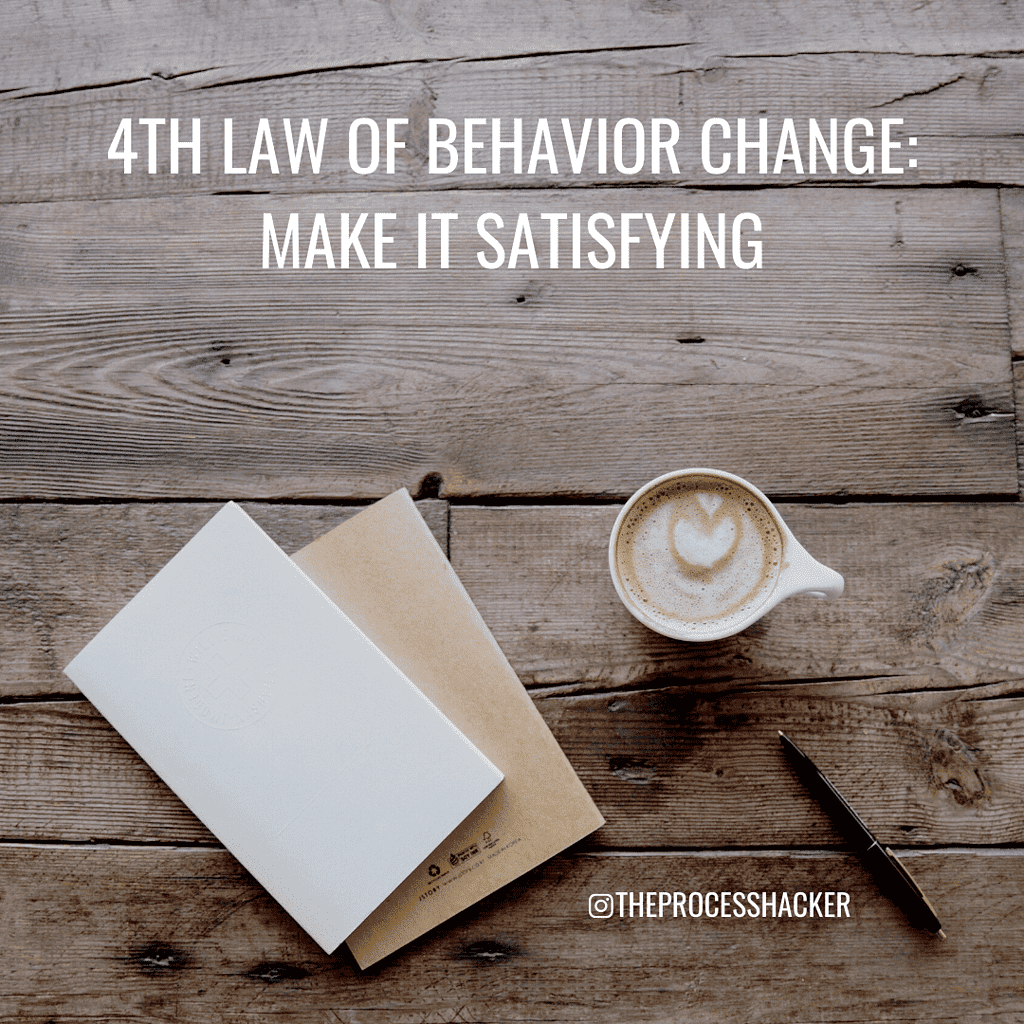
Chapter 15: The Cardinal Rule Of Behavior Change
In Chapter 15 of Atomic Habits, James Clear helps you implement the Cardinal Rule of Behavior Change. We repeat satisfying behaviors in the future based on whether we were rewarded or punished for what we did in the past. This idea in human nature gives way to the Cardinal Rule: “What is rewarded is repeated. What is punished is avoided.”
While the previous laws increase the chance of performing a habit in the present, the fourth law improves us doing so in the future. But there is an internal mismatch between the types of rewards in the following two environments:
- Immediate-Return Environment – the early-human societal environment in which your actions instantly deliver clear and immediate outcomes
- Delayed-Return Environment – the modern societal environment in which your actions occur for a while before delivering the intended payoff
While our brains have not evolved much, we still prioritize immediate rewards, but our society has shifted to value delayed gratification. And so, the updated Cardinal Rule reflects this idea:
Cardinal Rule of Behavior Change: “What is immediately rewarded is repeated. What is immediately punished is avoided.”
Therefore, to get your habits to stick, you need to determine how to attain some immediate success or give yourself an immediate reward.
Chapter 16: How To Stick With Good Atomic Habits Every Day
In Chapter 16 of Atomic Habits, James Clear shows you how to be consistent with your habits by tracking them daily. Specifically, you can see your progress is on a habit tracker:
Habit Tracker – a visual system to measure when you performed a habit or chain of habits, which has the following benefits:
- Obvious: Creates a visual indication that can remind you to take action.
- Attractive: Produces internal motivation by showing you the progress being made and helping you avoid breaking the chain.
- Satisfying: Gives fulfillment when you record another successful iteration of your habit.
Many people dislike habit tracking as you have to create two habits: the habit to build and the habit of tracking it. So, there are three ways to make habit tracking easier:
- Automate the metrics you are tracking and create a reminder to review periodically.
- Manually track your most important habits consistently.
- Record each data point immediately after the habit occurs. This method combines habit stacking with habit tracking: “After [CURRENT HABIT], I will [TRACK MY HABIT].”
Eventually, every habit streak will end at a certain point due to some interruption. If you forget or selectively miss a habit, you should immediately get back on track and never miss twice.
However, tracking has a downside as we can get absorbed by the metrics rather than the purpose behind it. Therefore, habit tracking has a role, but it is not the only thing that matters. Tracking is useful when it provides feedback and adds context to the big picture. There are many ways to determine progress, so avoid being consumed by habit tracking.
Chapter 17: How An Accountability Partner Can Change Everything
In Chapter 17 of Atomic Habits, James Clear discusses the inversion of the 4th Law of Behavior Change, which is to “Make it Unsatisfying.” Pain is an effective teacher, as we are less likely to repeat a bad habit if it is painful or unsatisfying. And so, when making mistakes, the more immediate and expensive ones will cause us to learn faster and more effectively from them.
However, the strength of the pain must match the strength of the behavior that we are trying to change. Therefore, the best method to create an immediate social cost to inaction is employing the Habit Contract:
Habit Contract – a self-imposed social cost to any behavior with the cost of violation being public and painful
Additionally, we are always trying to show our best selves to the world and genuinely care about what other people think about us. So we can create immediate costs of avoiding bad habits by getting an Accountability Partner:
Accountability Partner – another person that watches your behavior and holds
Actions:
- When you complete your habit, reward yourself immediately.
- Use a habit tracker to measure your streak and avoid breaking the chain.
- When you forget or selectively miss a habit, get back on track, and never miss twice.
- Get an accountability partner for someone to watch your behavior.
- Create a social control to incentivize against bad behavior.
Download James Clear’s atomic habits chapter summaries pDF
Advanced Tactics Of Atomic Habits
In this part of Atomic Habits, James Clear builds on the concepts of the Four Laws of Behavior Change with a few advanced tactics.

Chapter 18: The Truth About Talent (When Genes Matter And When They Don’t)
In Chapter 18 of Atomic Habits, James Clear discusses the amount one can accomplish with talent versus hard work. You can maximize your chances of succeeding by picking the right habits and field of competition for you:
- Pick the right habit, and progress is easy.
- Pick the wrong habit, and life is a struggle.
You have genes that influence your habits and behavior. They can be advantageous in favorable circumstances and a severe disadvantage in unfavorable situations. The most proven personality breakdown is as follows:
Big Five – a scientific analysis of personality traits broken down into five spectrums of behavior:
- Openness to Experience: Curious/Inventive to Cautious/Consistent.
- Conscientiousness: Organized/Efficient to Easygoing/Spontaneous.
- Extroversion: Outgoing/Energetic (Extroverts) to Solitary/Reserved (Introverts).
- Agreeableness: Friendly/Compassionate to Challenging/Detached.
- Neuroticism: Anxious/Sensitive to Confident/Calm/Stable.
Thus, build good habits and find a game that aligns with your personality and natural strengths by using the explore/exploit trade-off. First, undergo exploration at the start of a new activity. Then, when exploring options, ask these Atomic Habits discussion questions to help you pick habits and interests:
- What is fun for me, but works for others?
- What causes me to lose track of time?
- Where do I get higher returns than the average person?
- What things come naturally to me?
After exploring, focus on the best solution with occasional experimentation. With consistent wins, you should explore. However, if you are currently losing, then explore. If you can’t find a field that aligns with your abilities, create your own niche, or combine other interests.
Hard work still matters for success, as “hard work beats talent when talent doesn’t work hard.” Thus, your genes provide clarity and can influence what you choose to work hard on.
Chapter 19: The Goldilocks Rule: How To Stay Motivated In Life And Work
In the fairy tale, “Goldilocks and the Three Bears,” Goldilocks chooses Baby Bear’s chair, porridge, and bed (over Papa and Mama Bear’s) because it is “just right.” In Chapter 19 of Atomic Habits, James Clear shows you how to stay motivated using the Goldilocks Rule:
Goldilocks Rule – states that humans experience peak motivation when working on tasks that are right on the edge of their current abilities

The Goldilocks Rule describes an optimum to take on habits at a manageable difficulty that is not too hard, not too easy, but just right. Therefore, once a habit is established, you want to keep engaging in challenges on the edge of manageable difficulty to stay engaged. Check out Todoist or ClickUp for help with managing habits and tasks.
Improvement requires a delicate balance. Without variety, we get bored and struggle to stay motivated. Boredom is actually the greatest threat to success is, not failure. Routine habits become less exciting, engaging, and gratifying.
Thus, we need to fight boredom, as when one is motivated, they are willing to work hard. You should embrace boredom and doing nothing enjoyable to push through to be successful. The people that are professionals stick to their schedule, while amateurs don’t make it very far.
Chapter 20: The Downside To Creating Atomic Habits
In Chapter 20 of Atomic Habits, James Clear states that creating habits has excellent benefits; however, it can also come at a cost:
- Upside – allows us to do simple things without thinking and pay attention to the details
- Downside – causes us to stop paying attention to little errors and feedback
However, you need to challenge and improve yourself and your habits to reach higher levels of performance. Your goal should be to maximize your potential and achieve Mastery:
Mastery = Habits + Deliberate Practice
We achieve Mastery by combining our automatic habits with deliberate practice to grow and build on that growth to establish a new level of performance. It is a continuous cycle to work hard, gain success, and repeat to overcome the next challenge.

You can keep creating good habits, but you also need to reflect and review to grow:
Reflection and Review – the process that allows you to remain conscious of your performance over time to improve your habits in the long term; there are two primary modes:
- Annual Review – yearly reflection on your progress that asks these three questions:
- What went well this year?
- What didn’t go so well this year?
- What did I learn?
- Integrity Report – mid-year report that to realize mistakes, revisit core values, and reflect on identity by asking these questions:
- What are the core values that drive my life and work?
- How am I living and working with integrity right now?
- How can I set a higher standard in the future?
Lastly, we need to be careful of holding onto an identity as it limits our growth beyond that identity. “The key to mitigating these losses of identity is to redefine yourself such that you get to keep important aspects of your identity even if your particular role changes.”
Download The PDF Book Summary For Atomic Habits By James Clear
Next Steps
When you use the power of atomic habits, you can create great habits and break bad ones. I hope this post will help you create habits to help you change your identity and achieve your goals.
Also, I hope you are inspired to get your own copy of Atomic Habits. For further reading on habits, check out The Power of Habit (book summary) by Charles Duhigg.







